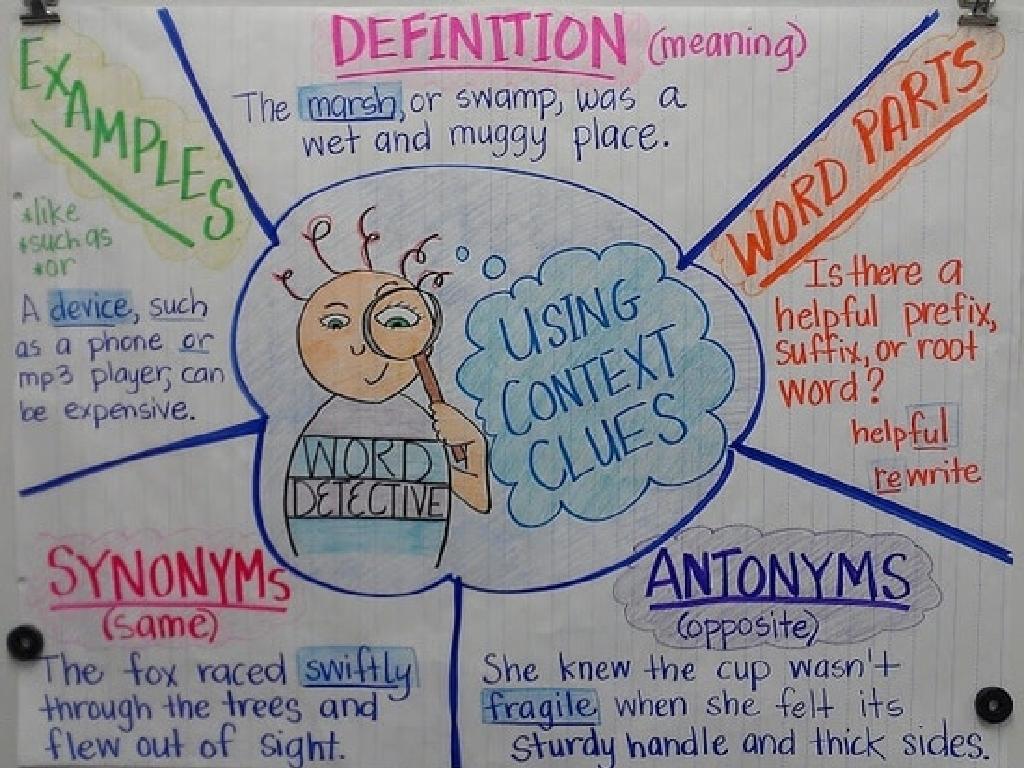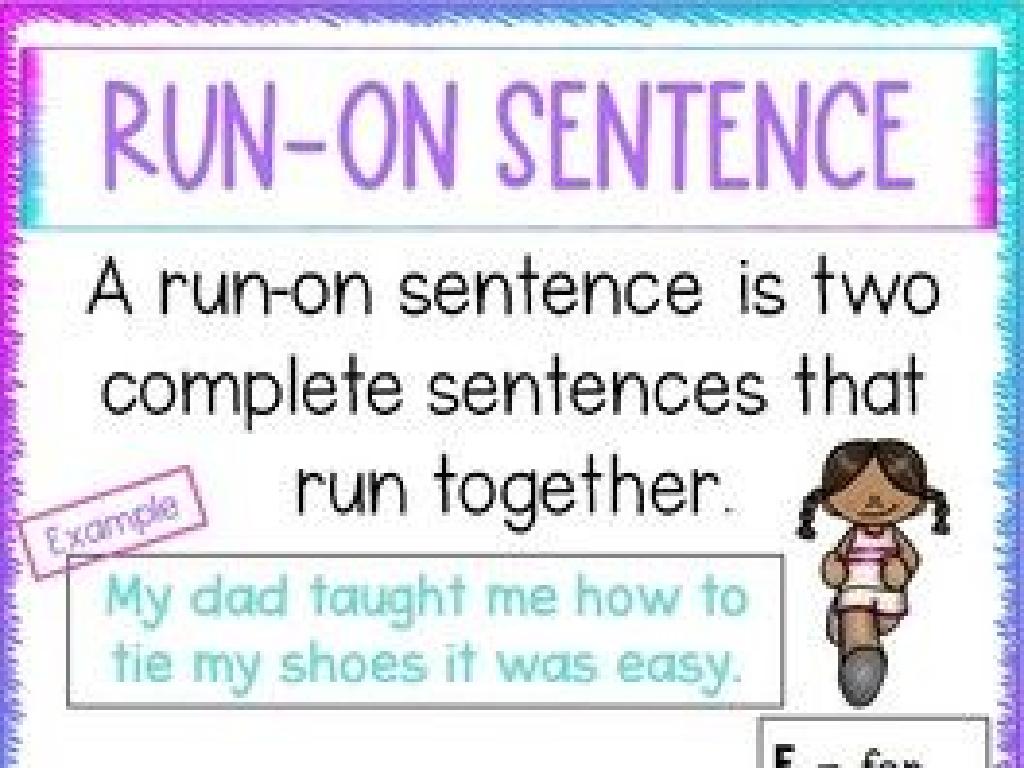Multi-Step Word Problems: Identify Reasonable Answers
Subject: Math
Grade: Sixth grade
Topic: Mixed Operations: Whole Numbers
Please LOG IN to download the presentation. Access is available to registered users only.
View More Content
Tackling Multi-Step Word Problems
– Understanding multi-step problems
– A problem involving two or more operations, like addition then division.
– Importance of complex problem-solving
– Solving these prepares you for real-world challenges and improves critical thinking.
– Real-life multi-step examples
– Planning a party budget or calculating travel time with multiple stops.
– Strategies for finding reasonable answers
– Use estimation and check if your answer makes sense in the context of the problem.
|
This slide introduces students to the concept of multi-step word problems, which require more than one operation to solve. Emphasize the value of these problems in developing critical thinking skills and preparing for real-life situations, such as budgeting or planning a trip. Provide examples that students can relate to and discuss strategies for approaching these problems, such as breaking them down into smaller steps, estimating, and checking the reasonableness of answers. Encourage students to think about the logical sequence of operations and to always consider the context of the problem when determining if an answer is reasonable.
Breaking Down Multi-Step Word Problems
– Read the problem thoroughly
– Understand the story and details
– Identify required operations
– Look for keywords: sum, difference, product, quotient
– Determine the goal of the problem
– What is the final question asking for?
– Consider reasonableness of answers
– Does the answer make sense in real life?
|
This slide is aimed at teaching students a systematic approach to solving multi-step word problems. Start by reading the problem carefully to understand the scenario. Next, identify the operations involved by looking for keywords that indicate addition, subtraction, multiplication, or division. Clarify the goal of the problem by understanding what the final question is asking for. Finally, encourage students to assess the reasonableness of their answers by checking if they make sense in the context of the problem. Provide examples of unreasonable answers and discuss why they do not fit the problem’s context.
Identifying Reasonable Answers in Word Problems
– Understanding reasonableness
– An answer is reasonable if it makes sense in the context of the problem.
– Estimation techniques
– Use rounding and approximating to predict a rough answer before solving.
– Logical evaluation of answers
– Apply common sense and math knowledge to assess if an answer is plausible.
– Practice with real-world problems
|
This slide aims to teach students how to determine if their answers to multi-step word problems are reasonable. Start by discussing what it means for an answer to be reasonable, emphasizing that it should ‘make sense’ within the context of the problem. Introduce estimation as a tool for making an educated guess about the answer, which can then be used to check the actual work. Highlight the importance of using logical thinking to evaluate answers, asking questions like ‘Does this answer fit the scenario of the problem?’ Provide examples of real-world problems and guide students through the process of estimation, solving, and then logically evaluating their answers. Encourage students to always question the reasonableness of their answers as a final step in problem-solving.
Solving Multi-Step Word Problems
– Read the problem together
– Break down the steps required
– Identify keywords and numbers involved
– Discuss various solution strategies
– Could use drawing, equations, or logical reasoning
– Determine a reasonable answer
– Answer should make sense with the problem context
|
This slide is aimed at teaching students how to approach multi-step word problems methodically. Start by reading the problem as a class to ensure understanding. Next, guide students to identify and write down the steps needed to solve the problem, looking for keywords and numbers that signal operations. Discuss different strategies they might use, such as drawing a diagram, writing an equation, or using logical reasoning. Emphasize the importance of checking that their final answer is reasonable and fits within the context of the problem. Encourage students to explain their thought process and reasoning as they work through the problem.
Solving Multi-Step Word Problems Together
– Work through a problem as a class
– Apply problem-solving strategies
– Use strategies like breaking down the problem into smaller steps
– Verify the reasonableness of our answer
– Does the answer make sense given the context of the problem?
– Reflect on the problem-solving process
– Discuss what worked well and what could be improved
|
This slide is designed to engage the class in a collaborative problem-solving activity. Start by presenting a multi-step word problem to the class and encourage them to work together to find a solution. Guide them to apply problem-solving strategies such as identifying keywords, breaking down the problem into smaller, manageable steps, and performing the necessary operations in the correct order. Once a solution is reached, prompt the class to check if the answer is reasonable by considering the context of the problem. Does the answer make sense? Is it a plausible solution? Conclude the activity with a reflection on the process, discussing what strategies were effective and how the approach to solving complex problems can be improved. This will help students develop critical thinking and analytical skills that are essential in mathematics.
Multi-Step Word Problems: Practice
– Work on guided problems individually
– Collaborate on problems in groups
– Team up to tackle complex problems, enhancing understanding through teamwork
– Discuss various problem-solving methods
– There’s more than one way to solve a problem; consider different strategies
– Share and compare different solutions
– Present your solutions and learn from others’ approaches
|
This slide is focused on practice activities for multi-step word problems. Start with individual practice to allow students to attempt solving problems on their own, providing guided problems that help them apply what they’ve learned. Then, have students work in groups to encourage collaboration and discussion, which can lead to deeper understanding. Encourage students to share their problem-solving methods with the class, highlighting that different approaches can lead to the same correct answer. This will help students see the value in diverse thinking and improve their own problem-solving skills. For the teacher: prepare a set of problems of varying difficulty, facilitate group discussions, and ensure each group presents their findings to the class.
Class Activity: Crafting & Solving Word Problems
– Create a multi-step word problem
– Swap problems with another group
– Solve the exchanged problem
– Discuss the reasonableness of answers
– Is the answer logical given the context of the problem?
|
This activity is designed to engage students in creating and solving their own multi-step word problems, emphasizing the application of mixed operations with whole numbers. Divide the class into small groups and provide them with guidelines for creating a word problem that requires at least two different mathematical operations. After creating their problems, groups will exchange their problems with another group and work on finding solutions. Once solved, each group will present their original problem, the solution they received, and discuss whether the answer is reasonable based on the context of the problem. This will help students understand the importance of checking their work and thinking critically about the results. Provide examples of reasonable vs. unreasonable answers to guide the discussion.
Conclusion: Multi-Step Word Problems
– Recap on solving multi-step problems
– Applying knowledge to real life
– Use problem-solving steps in daily scenarios like budgeting or planning events
– Discuss key takeaways
– Share insights and strategies that worked
– Reflect on learning process
– Think about how these skills can help in future math topics and life challenges
|
This slide aims to wrap up the lesson on multi-step word problems by encouraging students to reflect on what they’ve learned and how they can use these skills outside the classroom. Start by summarizing the problem-solving steps we’ve covered. Then, prompt students to think of ways they can apply these steps to situations they encounter in their daily lives, such as managing their allowance or organizing tasks. Facilitate a class discussion where students can share their key takeaways and effective strategies. Finally, encourage them to consider how the skills they’ve developed will be useful in other areas of math and in overcoming real-world challenges. This reflection will help solidify their understanding and appreciation of the material.






